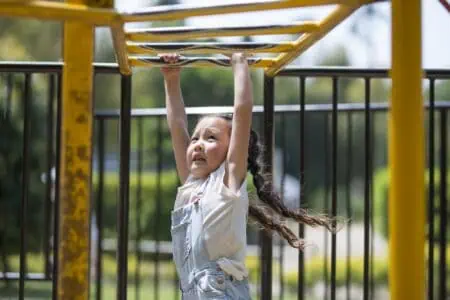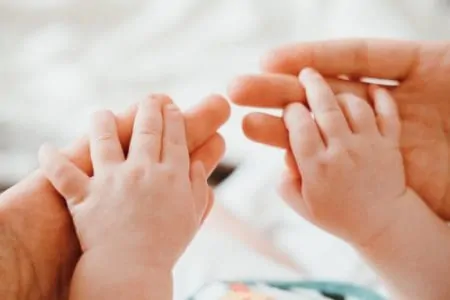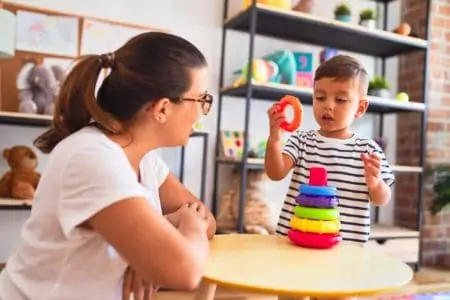Fine motor skills allow children to perform crucial daily tasks, such as picking up food, zipping a jacket, or holding a pencil. But how do you incorporate skill-building into your busy routine without it feeling like a chore?
Teaching fine motor control is simpler than it sounds. You can easily help your baby, toddler, or school-aged child hone these muscles through play.
From sensory bins to nature walks, we have compiled a list of engaging ideas. Get ready to boost your child’s development with 40 exciting fine motor activities for every age group.
What Are Fine Motor Skills?
Fine motor skills refer to the coordination of small muscles, specifically in the hands, wrists, fingers, feet, and toes (1). These small movements allow us to perform precise tasks. While gross motor skills involve large movements like running or jumping, fine motor skills set the foundation for writing, drawing, and self-care.
We use these skills constantly. Coordination between muscles, joints, nerves, and the brain allows us to type on a keyboard, turn a doorknob, or button a shirt.
Development begins early. A three-month-old baby uses fine motor skills to bat at a toy. A seven-year-old uses them to tie shoelaces or play a video game.
Developing these skills is vital for independence. They aid in communication, academics, and self-expression (2). Ultimately, fine motor mastery allows a child to explore and interact with their world confidently.
40 Fine Motor Skills Activities
If you are unsure where to start, we have you covered. Here are 40 activities to help your child strengthen their hands and fingers.
We have included age-appropriate ideas for newborns, toddlers, and older kids so you can find the perfect fit for your family.
Fun Crafts, Puzzles, and Games
Crafts and games are excellent for bonding and offer a sneaky way to build muscle strength.
1. Ripping Paper
This activity is cost-effective and surprisingly beneficial. Give your child colorful construction paper and encourage them to rip it into small pieces. Ripping requires the “tripod” grasp, which is essential for handwriting later on. Afterward, they can glue the scraps onto a fresh sheet to make a mosaic.
Age group: 2-5
2. Paper Plate Animals
Turn a plain paper plate into a favorite animal. Children can cut out shapes for ears, draw faces with markers, and glue on googly eyes. This project combines cutting, drawing, and pasting, which works on hand-eye coordination and bilateral coordination (using two hands together).
Age group: 3-7
3. Beaded Necklaces
Threading beads requires focus and steady hands. Have your child string beads onto yarn or pipe cleaners to create jewelry. This repetitive movement refines the pincer grasp and improves visual motor skills.
Age group: 4+
4. Jigsaw Puzzles
Puzzles challenge the brain and the fingers. For younger toddlers, the Melissa & Doug Wooden Peg Puzzles are an excellent choice because the sturdy pegs are easy to grasp. As children grow, move to floor puzzles and eventually standard jigsaw puzzles with smaller pieces to increase the difficulty.
Age group: 9 months+
5. Lacing Cards
Lacing cards strengthen the small muscles used for writing. You can create your own with cardboard and a hole punch, or opt for a durable set. The KLT Store Lacing Cards feature fun animal designs and sturdy laces, making them perfect for repeated use by toddlers.
Age group: 1-4
6. Shopping List Game
Board games are a fun way to practice picking up small cards. The Orchard Toys Shopping List Game is a fan favorite. It encourages memory skills while requiring players to grasp small item tiles and place them into their cart, refining fingertip control.
Age group: 3+
7. Fishing for Letters
Magnetic fishing games are classic for a reason. This wooden fishing game challenges children to steady their hands to “catch” fish with a magnetic rod. It helps fine-tune hand-eye coordination while simultaneously teaching letter recognition.
Age group: 3-7
8. Twister
While Twister is a full-body game, it relies heavily on hand placement. Supporting body weight on open palms strengthens the arches of the hands and wrists. This upper body stability is crucial for fine motor tasks like writing.
Age group: 6+
Writing, Drawing, and Tracing
Writing and drawing are the most obvious fine motor tasks. Here are eight ways to make them fun.
9. Play Dough Writing
Writing on paper can get boring, so try writing in dough. Flatten a layer of play dough on the table. Have your child use a wooden skewer or a chopstick to carve letters or shapes. The resistance of the dough provides sensory feedback that paper cannot offer.
Age group: 3-6
10. Pushpin Maze
This activity is strictly for older children who can handle sharp objects safely. Draw a letter or shape on paper and place it on a corkboard. Have your child place pushpins along the lines. This requires precise pincer grip and significant finger strength.
Age group: 6+
11. Sidewalk Chalk
Drawing vertically or on the ground changes the wrist angle and builds shoulder stability. Keep a bucket of Crayola Sidewalk Chalk handy. The friction of chalk against pavement gives extra feedback to the muscles, helping children learn how much pressure to apply.
Age group: 3-12
12. Alphabet Tracing
Tracing guides the hand to form correct shapes. Start with simple lines and move to letters. The Trace Letters: Alphabet Handwriting Practice workbook provides large, clear dotted lines to help children build muscle memory for the alphabet.
Age group: 3-7
13. Dot-To-Dot Pictures
Connecting dots teaches children to draw straight lines and change direction with control. It also reinforces number sequencing. The School Zone – Numbers 1-25 Workbook offers fun hidden pictures that reward your child’s precision with a fun image to color.
Age group: 3+
14. Squiggle Art
Encourage creativity with abstract art. Give your child markers and ask them to draw continuous loops and squiggles without lifting the pen. This promotes fluid arm movements and helps loosen up a stiff grip.
Age group: 3+
15. Cursive Writing
Connecting letters in cursive requires sustained control and focus. It aids in speed and writing fluidity. For extra practice at home, the Hippidoo Cursive Handwriting Workbook breaks down the strokes simply for beginners.
Age group: 7-10
16. Watercolor Resist Art
Draw a design with a white crayon on white paper. Then, paint over it with watercolors. The wax resists the paint, revealing the hidden image. This activity encourages children to press hard with the crayon (strength) and brush lightly with the paint (control).
Age group: 5-10
Hygiene and Self-Care Skills
Self-care tasks are functional fine motor workouts. Mastering these builds confidence and independence.
17. Brushing Teeth
Rotating the toothbrush to reach back teeth requires complex wrist movements. While you may need to finish the job for young kids, let them start. Squeezing the toothpaste tube is also excellent for thumb strength.
Age group: 3+
18. Self-Feeding
Using utensils is a major milestone. Start with finger foods to practice the pincer grasp. As they grow, introducing spoons and forks challenges their hand-eye coordination. By age one, many toddlers can bring a loaded spoon to their mouth.
Age group: 6 months+
19. Washing Hands
Rubbing soap between fingers, interlacing them, and turning the tap on and off all require dexterity. Make this a consistent part of the routine to build muscle memory and hygiene habits simultaneously.
Age group: 12 months+
20. Tying Shoelaces
This is the “final boss” of early childhood fine motor skills. It requires bilateral coordination, finger isolation, and patience. Once a child masters this, their finger dexterity is usually quite advanced.
Age group: 5-7
21. Brushing Hair
Grip strength is key here. Holding a brush and pulling it through hair provides resistance that strengthens the hand. Later, learning to use hair ties or clips adds a layer of complex manipulation.
Age group: 3+
22. Bathroom Hygiene
Wiping requires reaching, grasping, and applying appropriate pressure without visual cues. It is a complex motor sequence that children practice daily. Folding toilet paper also works on delicate finger movements.
Age group: 5-7
23. Cooking a Meal
Kitchen tasks are goldmines for motor skills. Stirring batter, chopping soft fruits with a kid-safe knife, or measuring ingredients engages the hands in functional ways. It also teaches safety and sequencing.
Age group: 8+
24. Clipping Nails
Operating nail clippers requires high precision and force. It is tricky, so supervise closely. For pre-teens, this is a great practical life skill that refines fine motor control.
Age group: 10+
Sensory Play
Sensory play engages the tactile system, which is closely linked to hand skills.
25. Texture Exploration
Babies learn by touching. Offer various fabrics like silk, wool, or crinkly paper. Grasping and releasing these different textures helps infants map their hand movements and desensitizes tactile defensiveness.
Age group: 0-2
26. Cotton Ball Painting
Ditch the paintbrush for a day. Have kids dip cotton balls in paint and throw them at a paper taped to the wall. This engages the grasp and release motion and works on arm strength.
Age group: 5-10
27. Stickers
Peeling the back off a sticker is one of the best exercises for the pincer grasp. It requires using the very tips of the thumb and index finger. Plus, positioning the sticker on paper refines spatial awareness.
Age group: 2+
28. Sensory Bin
Fill a bin with rice, beans, or pasta. Hide small toys inside for your child to find. Digging, scooping, and pouring materials are foundational for tool use.
Age group: 0-5
Warning
Do not include choking hazards. If your child is younger than three, avoid anything small enough to fit inside a toilet roll tube.
29. Clay Sculpting
Modeling clay is stiffer than play dough, offering more resistance. This builds hand arch strength. Crayola Air Dry Clay is easy to work with and hardens overnight so kids can paint their creations later.
Age group: 10+
30. Sewing Projects
Threading a needle and stitching requires intense focus and steady hands. It improves visual acuity and precision. Start with large plastic needles and burlap before moving to real sewing kits.
Age group: 10+
31. Tactile Sensory Cards
Create cards with glued-on textures like sandpaper, velvet, or bubble wrap. Touching these helps babies isolate their index finger to explore, a precursor to pointing and tracing.
Age group: 0-1
32. Proprioception Activities
Proprioception tells us where our body is in space. Heavy work activities, like squeezing a wet sponge, kneading dough, or carrying a heavy bucket, wake up the muscles and joints in the hands.
Age group: 0+
Outdoor Activities In Nature
Nature provides the best playground for motor development.
33. Sandbox Play
Sand offers resistance. Digging with hands, filling buckets, and molding shapes strengthens the fingers and wrists. Writing in wet sand with a stick is also a great pre-writing activity.
Age group: 0+
34. Popping Bubbles
Chasing and popping bubbles encourages visual tracking and finger isolation. Children must point their finger accurately to pop the bubble, which is excellent for eye-hand coordination.
Age group: 0-6
35. Make Stew
Encourage your child to gather leaves, rocks, and twigs to stir into a “stew.” Picking up tiny items from the ground (nature’s pincer grasp practice) and stirring with a large stick works both fine and gross motor skills.
Age group: 3-6
36. Planting Flowers and Vegetables
Gardening involves digging, handling tiny seeds, and gently patting soil. These varied movements require the hands to grade their force, knowing when to be strong and when to be gentle.
Age group: 3+
37. Rock Painting
Painting on a 3D object like a rock is harder than painting on flat paper. The child must stabilize the rock with one hand while painting with the other. The JOYIN Glow in the Dark Kit adds a fun element that gets kids excited to create.
Age group: 3+
38. Ball Games
Catching a ball requires the hands to open and close at the exact right moment. Start with large beach balls and move to smaller tennis balls to refine grasp timing and reaction speed.
Age group: 3+
39. Monkey Bars
Hanging from bars is the ultimate grip strengthener. Strong hands are necessary for holding pencils without fatigue. While often seen as gross motor play, the grip requirement is vital for fine motor endurance.
Age group: 3+
40. Smashing Ice
Freeze small toys in a muffin tin filled with water. Give your child a spray bottle (warm water) or a small mallet to free the toys. Using a spray bottle is fantastic for strengthening the hand muscles needed for scissor skills.
Age group: 4-8
How to Improve Fine Motor Skills
Beyond specific activities, you can encourage development through daily habits.
- Expose your child to textures: Introduce various materials early. Touching different surfaces engages nerve endings and encourages finger movement.
- Try Baby-led weaning: Let your child feed themselves finger foods. This naturally trains the pincer grasp and utensil use without pressure.
- Involve them in chores: Simple tasks like setting the table, sorting socks, or picking up toys build motor planning skills.
- Encourage dressing skills: Let toddlers practice pulling up pants or pushing buttons. It builds patience and finger strength.
- Use child-safe tools: Let them use kid-safe knives or hammers alongside you. Imitation is a powerful learning tool.
- Follow their interests: If they hate coloring, try LEGO. If they dislike puzzles, try gardening. The best activity is one they enjoy.
- Participate: Sit with them. Your presence makes boring tasks like handwriting practice feel like a game.
- Strengthen hand muscles: Squeezing stress balls, spray bottles, or play dough prepares the hand for precision work.
- Create opportunities: Leave interesting manipulatives out. Make fine motor play accessible rather than a scheduled lesson.
- Play board games: Board games naturally require handling small pieces, dice, and cards.
FAQs
Working On Fine Motor Skills Daily
Fine motor development is essential for your child’s independence. These skills empower them to feed themselves, dress themselves, and eventually succeed in school tasks like writing.
With these 40 diverse activities, you have plenty of options to keep things fresh. Whether your child prefers messy sensory play, quiet puzzles, or running around outside, there is a fun way to build those hand muscles every single day.









